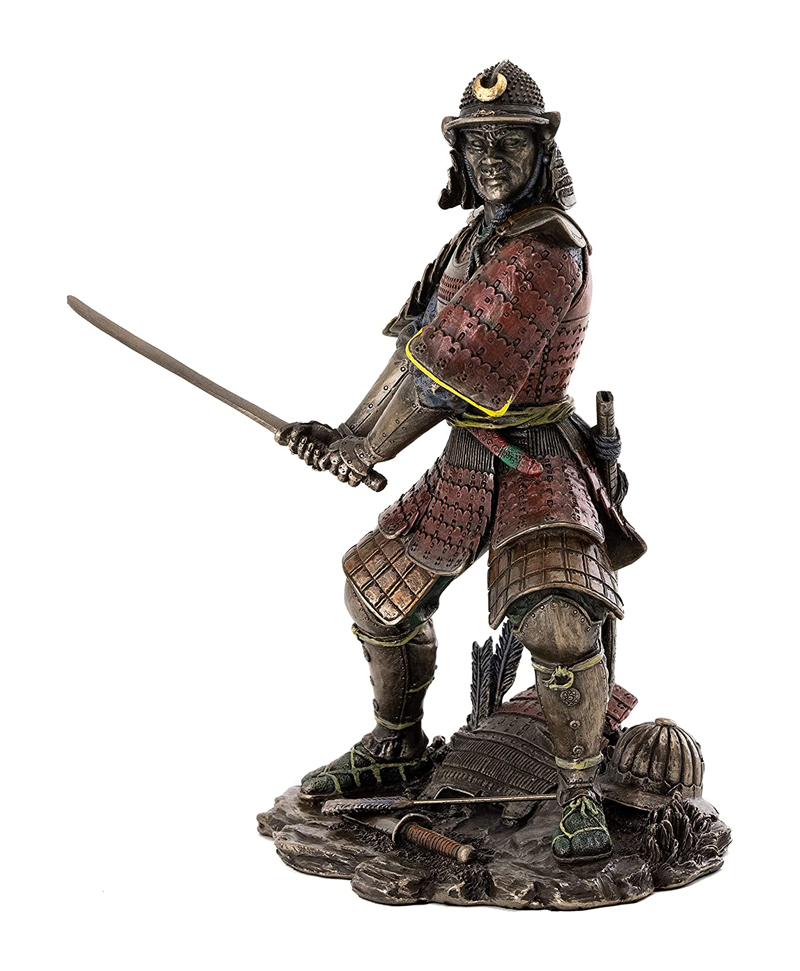Medieval Japanese Samurai “General Minamoto no Yoshitsune” Statue
Medieval Japanese Samurai Statue premium sculpted cold cast bronze with real bronze powder mixed with resin. Hand-painted in bronze finish to give a high-quality antique look without sacrificing the details. Beautiful decor to display in your home, office, or library. Great addition to any Japanese Samurai collection. BUSHIDO – The code of honor and morals developed by the Japanese samurai. Minamoto no Yoshitsune (1159 – June 15, 1189) was a Japanese military, samurai and general of the Minamoto clan, who lived between the end of the Heian period and the beginning of the Kamakura period, one of the last dead before that the shogun became the absolute ruler of the country for nearly 7 centuries. He had started the war against the Taira as a teenager and was 28 at the time of his death. Taken as an example as a samurai, he is considered the greatest warrior in the history of Japan. Yoshitsune was the 4th and last son of the warlord Minamoto no Yoshitomo, Head of the Minamoto clan, and a concubine, Tokiwa Gozen. Shortly after his birth, at the end of 1159, the Heiji rebellion broke out, in which his father and 2 older brothers lost their lives.
While his elder brother Yoritomo, son of the official wife and now designated heir of the clan, was exiled to Izu province, Yoshitsune was entrusted to the Kurama temple, in the Hiei mountains, near Kyoto, where he grew up under the name of Ushiwakamaru. On Mount Kurama, he learned kenjutsu (fencing with the katana) from the king of the tengu, Sojobo. Eventually, he was taken into custody by Fujiwara no Hidehira, head of the mighty northern branch of the Fujiwara (Northern Fujiwara) clan, and was taken to Hiraizumi, Mutsu province. In 1180, Yoshitsune learned that his brother Yoritomo, now head of the clan, had gathered the armies of the Minamoto to face those of the Taira clan. Yoshitsune, along with his very faithful friend Benkei, took part in the conflict. In the battle of Awazu, in Omi province, in early 1184, he defeated and killed his cousin Yoshinaka, Yoritomo’s rival for the post of clan chief, then proclaimed himself a shogun for a short time. A month later, in the battle of Ichi-no-Tani, in today’s Kobe, he defeated the Taira and repeated the feat, in 1185, in the battles of Yashima, on the Island of Shikoku, and Dan-no-ura, in the present Yamaguchi prefecture.
After the Genpei War, Yoshitsune heeded the appeal of the cloistered emperor Go-Shirakawa, whose power had now greatly diminished, to take up arms against his envious brother Yoritomo, who felt threatened by his reputation as an invincible warrior at the court imperial and prevented his appointment as shogun. Defeated and accused of treason for the emperor’s support, Yoritomo ordered checkpoints to be set up across the country to capture him, so in 1187 he had to return to enlist the help of Fujiwara no Hidehira. There, in Mutsu province, Yoshitsune was betrayed by Hidehira’s son, Yasuhira, and forced to perform seppuku, along with his wife Sato Gozen and daughter, to escape capture by Yoritomo’s warriors. In 1192, 3 years after his death, Go-Shirakawa and Yoritomo reconciled, and Yoritomo received the title of shogun, founding the Kamakura Shogunate and becoming April 26 of that year, after the death of the last true absolute ruler, the effective governor of Japan. His head was captured and sent to his brother. He was buried in the Shirahata Jinja Shinto temple in Fujisawa, where his body is still kept today. Medieval Japanese Samurai “General Minamoto no Yoshitsune” Statue measures: 6 inches / 15 cm x 4 inches / 10 cm x 8.3 inches / 21 cm.
Medieval Japanese Samurai Statue on Amazon.
Medieval Japanese Samurai Statue on eBay.
Medieval Statues, Japanese Statues and Samurai Statues.







You must be logged in to post a comment.